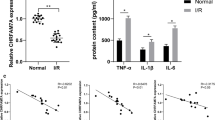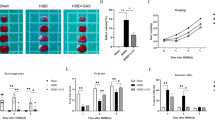Abstract
Accumulating evidence indicates that post-injury inflammation characterized by activated microglia contributes much to the neuropathology of ischemic injury. Several studies have demonstrated that microglia exhibit two entirely different functional activation states, referred to as classically activated (M1) and alternatively activated (M2) phenotype. Promoting microglial phenotype to switch from M1 dominant to M2 dominant might be a promising approach for handling ischemic injury. However, the comprehensive mechanism that underlines microglia polarization in ischemic brain remains unclear. Neuronal erythropoietin-producing human hepatocellular carcinoma cell receptor 4 (EphA4), the richest Eph receptor in the central nervous system (CNS), upregulate after ischemia and may have the potential to regulate microglia activation. We hypothesized that modulating EphA4/ephrin signaling could affect ischemic injury through controlling microglia polarization. We therefore knocked down neuronal EphA4 with short hairpin RNA (shRNA) and determined the role of EphA4/ephrin signaling in oxygen-glucose deprivation and reperfusion (OGD/R)-induced injury. We found that EphA4 shRNA treatment attenuated OGD/R-induced apoptosis and microglia proliferation. Neuronal EphA4 knockdown also promoted microglial M2 polarization, which reduced pro-inflammatory mediators and released anti-inflammatory cytokines as well as neurotrophic factors. We further revealed that EphA4 shRNA treatment functioned through RhoA/Rho-associated kinase 2 (ROCK2) signaling, a key mediator of microglia alternative activation. Together, these data suggested that blockage of EphA4/ephrin signaling between neuron and microglia decreased OGD/R-induced injury by promoting alternative activation of microglia via RhoA/ROCK2 signaling.





Similar content being viewed by others
References
Borrajo, A., A.I. Rodriguez-Perez, B. Villar-Cheda, M.J. Guerra, and J.L. Labandeira-Garcia. 2014. Inhibition of the microglial response is essential for the neuroprotective effects of Rho-kinase inhibitors on MPTP-induced dopaminergic cell death. Neuropharmacology 85: 1–8. https://doi.org/10.1016/j.neuropharm.2014.05.021.
Carmona, M.A., K.K. Murai, L. Wang, A.J. Roberts, and E.B. Pasquale. 2009. Glial ephrin-A3 regulates hippocampal dendritic spine morphology and glutamate transport. Proceedings of the National Academy of Sciences of the United States of America 106 (30): 12524–12529. https://doi.org/10.1073/pnas.0903328106.
Cherry, J.D., J.A. Olschowka, and M.K. O’Banion. 2014. Neuroinflammation and M2 microglia: the good, the bad, and the inflamed. Journal of Neuroinflammation 11: 98. https://doi.org/10.1186/1742-2094-11-98.
Corraliza, I.M., G. Soler, K. Eichmann, and M. Modolell. 1995. Arginase induction by suppressors of nitric oxide synthesis (IL-4, IL-10 and PGE2) in murine bone-marrow-derived macrophages. Biochemical and Biophysical Research Communications 206 (2): 667–673. https://doi.org/10.1006/bbrc.1995.1094.
Elbashir, S.M., J. Harborth, W. Lendeckel, A. Yalcin, K. Weber, and T. Tuschl. 2001. Duplexes of 21-nucleotide RNAs mediate RNA interference in cultured mammalian cells. Nature 411 (6836): 494–498. https://doi.org/10.1038/35078107.
Fan, R., B. Enkhjargal, R. Camara, F. Yan, L. Gong, J. Tang ShengtaoYao, Y. Chen, and J.H. Zhang. 2017. Critical role of EphA4 in early brain injury after subarachnoid hemorrhage in rat. Experimental Neurology 296: 41–48. https://doi.org/10.1016/j.expneurol.2017.07.003.
Fang, Q., A. Strand, W. Law, V.M. Faca, M.P. Fitzgibbon, N. Hamel, B. Houle, X. Liu, D.H. May, G. Poschmann, L. Roy, K. Stühler, W. Ying, J. Zhang, Z. Zheng, J.J.M. Bergeron, S. Hanash, F. He, B.R. Leavitt, H.E. Meyer, X. Qian, and M.W. McIntosh. 2009. Brain-specific proteins decline in the cerebrospinal fluid of humans with Huntington disease. Molecular & Cellular Proteomics 8 (3): 451–466. https://doi.org/10.1074/mcp.M800231-MCP200.
Filosa, A., S. Paixao, S.D. Honsek, M.A. Carmona, L. Becker, B. Feddersen, L. Gaitanos, et al. 2009. Neuron-glia communication via EphA4/ephrin-A3 modulates LTP through glial glutamate transport. Nature Neuroscience 12 (10): 1285–1292. https://doi.org/10.1038/nn.2394.
Fu, A.K., K.W. Hung, H. Huang, S. Gu, Y. Shen, E.Y. Cheng, F.C. Ip, X. Huang, W.Y. Fu, and N.Y. Ip. 2014. Blockade of EphA4 signaling ameliorates hippocampal synaptic dysfunctions in mouse models of Alzheimer’s disease. Proceedings of the National Academy of Sciences of the United States of America 111 (27): 9959–9964. https://doi.org/10.1073/pnas.1405803111.
Gingras, M., V. Gagnon, S. Minotti, H.D. Durham, and F. Berthod. 2007. Optimized protocols for isolation of primary motor neurons, astrocytes and microglia from embryonic mouse spinal cord. Journal of Neuroscience Methods 163 (1): 111–118. https://doi.org/10.1016/j.jneumeth.2007.02.024.
Hashimoto, R., Y. Nakamura, H. Kosako, M. Amano, K. Kaibuchi, M. Inagaki, and M. Takeda. 1999. Distribution of Rho-kinase in the bovine brain. Biochemical and Biophysical Research Communications 263 (2): 575–579. https://doi.org/10.1006/bbrc.1999.1409.
He, G.Q., W.M. Xu, J.F. Li, S.S. Li, B. Liu, X.D. Tan, and C.Q. Li. 2015. Huwe1 interacts with Gadd45b under oxygen-glucose deprivation and reperfusion injury in primary rat cortical neuronal cells. Molecular Brain 8: 88. https://doi.org/10.1186/s13041-015-0178-y.
Hu, X., R.K. Leak, Y. Shi, J. Suenaga, Y. Gao, P. Zheng, and J. Chen. 2015. Microglial and macrophage polarization-new prospects for brain repair. Nature Reviews. Neurology 11 (1): 56–64. https://doi.org/10.1038/nrneurol.2014.207.
Hu, X., P. Li, Y. Guo, H. Wang, R.K. Leak, S. Chen, Y. Gao, and J. Chen. 2012. Microglia/macrophage polarization dynamics reveal novel mechanism of injury expansion after focal cerebral ischemia. Stroke 43 (11): 3063–3070. https://doi.org/10.1161/STROKEAHA.112.659656.
Kemmerling, N., P. Wunderlich, S. Theil, B. Linnartz-Gerlach, N. Hersch, B. Hoffmann, M.T. Heneka, B. de Strooper, H. Neumann, and J. Walter. 2017. Intramembranous processing by gamma-secretase regulates reverse signaling of ephrin-B2 in migration of microglia. Glia 65 (7): 1103–1118. https://doi.org/10.1002/glia.23147.
Klein, R. 2009. Bidirectional modulation of synaptic functions by Eph/ephrin signaling. Nature Neuroscience 12 (1): 15–20. https://doi.org/10.1038/nn.2231.
Lemmens, R., T. Jaspers, W. Robberecht, and V.N. Thijs. 2013. Modifying expression of EphA4 and its downstream targets improves functional recovery after stroke. Human Molecular Genetics 22 (11): 2214–2220. https://doi.org/10.1093/hmg/ddt073.
Li, J., N. Liu, Y. Wang, R. Wang, D. Guo, and C. Zhang. 2012. Inhibition of EphA4 signaling after ischemia-reperfusion reduces apoptosis of CA1 pyramidal neurons. Neuroscience Letters 518 (2): 92–95. https://doi.org/10.1016/j.neulet.2012.04.060.
Livak, K.J., and T.D. Schmittgen. 2001. Analysis of relative gene expression data using real-time quantitative PCR and the 2(-Delta Delta C(T)) method. Methods 25 (4): 402–408. https://doi.org/10.1006/meth.2001.1262.
Ma, Y., J. Wang, Y. Wang, and G.Y. Yang. 2017. The biphasic function of microglia in ischemic stroke. Progress in Neurobiology 157: 247–272. https://doi.org/10.1016/j.pneurobio.2016.01.005.
Morris, S.M., Jr. 2007. Arginine metabolism: boundaries of our knowledge. The Journal of Nutrition 137 (6 Suppl 2): 1602S–1609S. https://doi.org/10.1093/jn/137.6.1602S.
Munro, K.M., V.M. Perreau, and A.M. Turnley. 2012. Differential gene expression in the EphA4 knockout spinal cord and analysis of the inflammatory response following spinal cord injury. PLoS One 7 (5): e37635. https://doi.org/10.1371/journal.pone.0037635.
Murai, K.K., L.N. Nguyen, F. Irie, Y. Yamaguchi, and E.B. Pasquale. 2003. Control of hippocampal dendritic spine morphology through ephrin-A3/EphA4 signaling. Nature Neuroscience 6 (2): 153–160. https://doi.org/10.1038/nn994.
Nakagawa, O., K. Fujisawa, T. Ishizaki, Y. Saito, K. Nakao, and S. Narumiya. 1996. ROCK-I and ROCK-II, two isoforms of Rho-associated coiled-coil forming protein serine/threonine kinase in mice. FEBS Letters 392 (2): 189–193.
Noren, N.K., and E.B. Pasquale. 2004. Eph receptor-ephrin bidirectional signals that target Ras and Rho proteins. Cellular Signalling 16 (6): 655–666. https://doi.org/10.1016/j.cellsig.2003.10.006.
Qin, H., R. Noberini, X. Huan, J. Shi, E.B. Pasquale, and J. Song. 2010. Structural characterization of the EphA4-Ephrin-B2 complex reveals new features enabling Eph-ephrin binding promiscuity. The Journal of Biological Chemistry 285 (1): 644–654. https://doi.org/10.1074/jbc.M109.064824.
Roser, A.E., L. Tonges, and P. Lingor. 2017. Modulation of microglial activity by Rho-kinase (ROCK) inhibition as therapeutic strategy in Parkinson’s disease and amyotrophic lateral sclerosis. Frontiers in Aging Neuroscience 9: 94. https://doi.org/10.3389/fnagi.2017.00094.
Scheiblich, H., and G. Bicker. 2017. Regulation of microglial phagocytosis by RhoA/ROCK-inhibiting drugs. Cellular and Molecular Neurobiology 37 (3): 461–473. https://doi.org/10.1007/s10571-016-0379-7.
Schmucker, D., and S.L. Zipursky. 2001. Signaling downstream of Eph receptors and ephrin ligands. Cell 105 (6): 701–704.
Shamah, S.M., M.Z. Lin, J.L. Goldberg, S. Estrach, M. Sahin, L. Hu, M. Bazalakova, R.L. Neve, G. Corfas, A. Debant, and M.E. Greenberg. 2001. EphA receptors regulate growth cone dynamics through the novel guanine nucleotide exchange factor ephexin. Cell 105 (2): 233–244.
Shu, Y., B. Xiao, Q. Wu, T. Liu, Y. Du, H. Tang, S. Chen, L. Feng, L. Long, and Y. Li. 2016. The Ephrin-A5/EphA4 interaction modulates neurogenesis and angiogenesis by the p-Akt and p-ERK pathways in a mouse model of TLE. Molecular Neurobiology 53 (1): 561–576. https://doi.org/10.1007/s12035-014-9020-2.
Takahashi, I., Y. Hama, M. Matsushima, M. Hirotani, T. Kano, H. Hohzen, I. Yabe, J. Utsumi, and H. Sasaki. 2015. Identification of plasma microRNAs as a biomarker of sporadic amyotrophic lateral sclerosis. Molecular Brain 8 (1): 67. https://doi.org/10.1186/s13041-015-0161-7.
Takeuchi, S., H. Katoh, and M. Negishi. 2015. Eph/ephrin reverse signalling induces axonal retraction through RhoA/ROCK pathway. Journal of Biochemistry 158 (3): 245–252. https://doi.org/10.1093/jb/mvv042.
Tatsumi, E., H. Yamanaka, K. Kobayashi, H. Yagi, M. Sakagami, and K. Noguchi. 2015. RhoA/ROCK pathway mediates p38 MAPK activation and morphological changes downstream of P2Y12/13 receptors in spinal microglia in neuropathic pain. Glia 63 (2): 216–228. https://doi.org/10.1002/glia.22745.
Xiao, H., Q. Huang, J.Q. Wang, Q.Q. Deng, and W.P. Gu. 2016. Effect of ephrin-B2 on the expressions of angiopoietin-1 and -2 after focal cerebral ischemia/reperfusion. Neural Regeneration Research 11 (11): 1784–1789. https://doi.org/10.4103/1673-5374.194723.
Yang, J., X. Luo, X. Huang, Q. Ning, M. Xie, and W. Wang. 2014. Ephrin-A3 reverse signaling regulates hippocampal neuronal damage and astrocytic glutamate transport after transient global ischemia. Journal of Neurochemistry 131 (3): 383–394. https://doi.org/10.1111/jnc.12819.
Yang, J.S., H.X. Wei, P.P. Chen, and G. Wu. 2018. Roles of Eph/ephrin bidirectional signaling in central nervous system injury and recovery. Experimental and Therapeutic Medicine 15 (3): 2219–2227. https://doi.org/10.3892/etm.2018.5702.
Zhang, H., Y. Li, J. Yu, M. Guo, J. Meng, C. Liu, Y. Xie, L. Feng, B. Xiao, and C. Ma. 2013. Rho kinase inhibitor fasudil regulates microglia polarization and function. Neuroimmunomodulation 20 (6): 313–322. https://doi.org/10.1159/000351221.
Zujovic, V., and V. Taupin. 2003. Use of cocultured cell systems to elucidate chemokine-dependent neuronal/microglial interactions: control of microglial activation. Methods 29 (4): 345–350.
Funding
This work was partly financially supported by the Fujian Provincial Natural Science Foundation (Grant nos. 2017J05123 and 2018J01175); Startup Fund for Scientific Research, Fujian Medical University (Grant No. 2016QH067); Young and Middle-aged Backbone Key Research Project of the National Health and Family Planning Commission of Fujian Province (Grant nos. 2017-ZQN-46 and 2018-ZQN-48); and the National Natural Science Foundation of China (Grant no. 81802492).
Author information
Authors and Affiliations
Corresponding authors
Ethics declarations
Conflict of Interest
The authors declare that they have no conflict of interest.
Electronic Supplementary Material
Figure S1
Co-staining of Iba1 (red) and GFP (green) in co-cultures. No double labeled cells were observed in (A3) which confirmed that microglia in co-cultures were not infected by EphA4 shRNA lentivirus. Scale bar = 100 μm. (PNG 2361 kb)
Rights and permissions
About this article
Cite this article
Wei, HX., Yao, PS., Chen, PP. et al. Neuronal EphA4 Regulates OGD/R-Induced Apoptosis by Promoting Alternative Activation of Microglia. Inflammation 42, 572–585 (2019). https://doi.org/10.1007/s10753-018-0914-4
Published:
Issue Date:
DOI: https://doi.org/10.1007/s10753-018-0914-4




